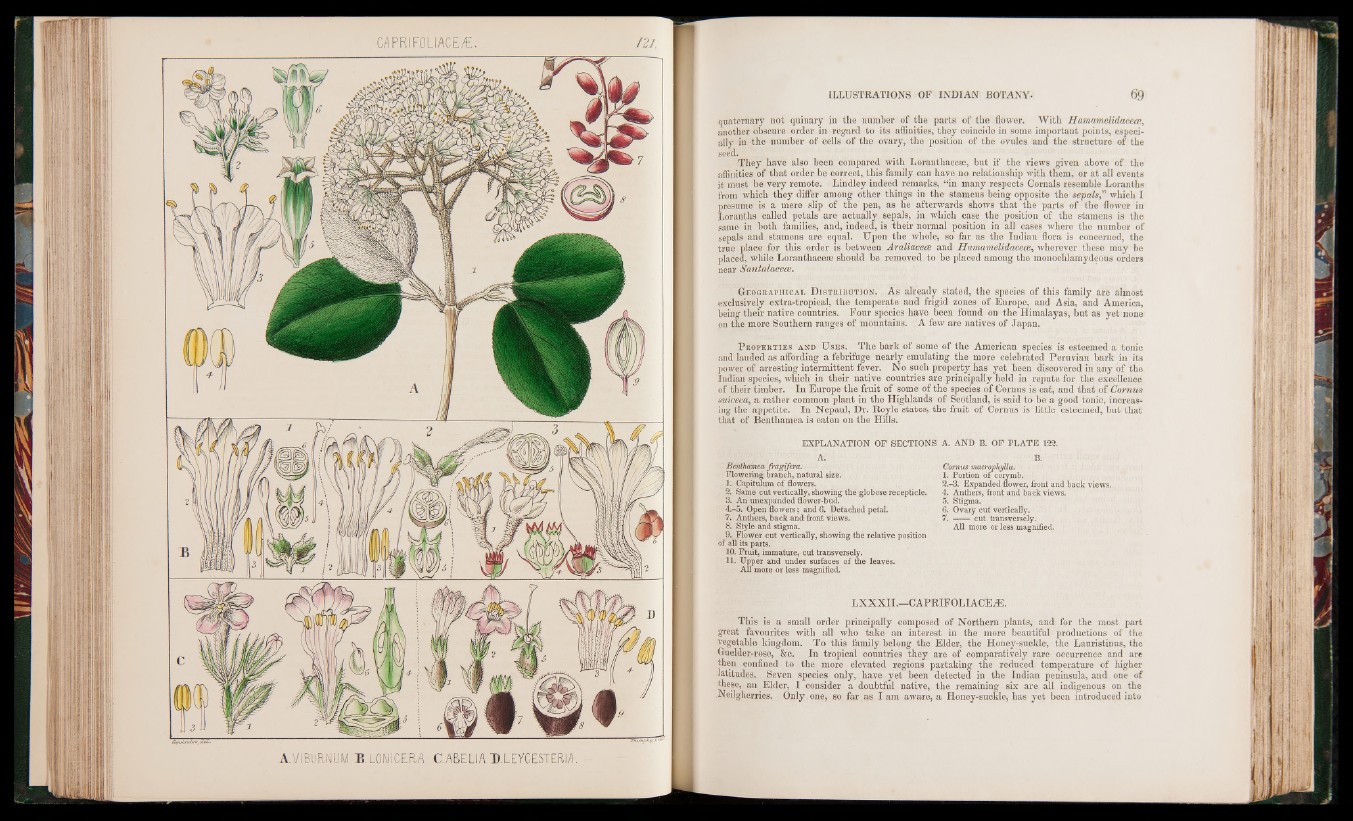
GAPRIF.OLIACEÆ.
A. VIBURNUM B. LOMICERA C. ABE LI A D.GEYCESTERJA.
quaternary not quinary in the number of the parts of the flower. With Hamamelidacece,
another obscure order in regard to its affinities, they coincide in some important points, especially
in the number of cells of the ovary, the position of the ovules and the structure of the
seed.
They have also been compared with Loranthacese, but if the views given above of the
affinities of that order be correct,, this family can have no relationship with them, or at all events
it must be very remote. Lindley indeed remarks, “in many respects Cornals resemble Loranths
from which they differ among other things in the stamens being opposite the sepals,” which I
presume is a mere slip of the pen, as he afterwards shows that the parts of the flower in
Loranths called petals are actually sepals, in which case the position of the stamens is the
same in both families, and, indeed, is their normal position in all cases where the number of
sepals and stamens are equal. Upon the whole, so far as the Indian flora is concerned, the
true place for this order is between Araliacece and Hamamelidacece, wherever these may be
placed, while Loranthaceae should be removed to be placed among the monochlamydeous orders
near Santalacece.
G eo graphical D is t r ib u t io n . A s already stated, the species of this family are almost
exclusively extra-tropical, the temperate and frigid zones of Europe, and Asia, and America,
being their native countries. Four species have been found on the Himalayas, but as yet none
on the more Southern ranges of mountains. A few are natives of Japan.
P roperties and U ses. The bark of some of the American species is esteemed a tonic
and lauded as affording a febrifuge nearly emulating the more celebrated Peruvian bark in its
power of arresting intermittent fever. No such property has yet been discovered in any of the
Indian species, which in their native countries are principally held in repute for the excellence
of their timber. In Europe the fruit of some of the species of Cornus is eat, and that of Cornus
suiceca, a rather common plant in the Highlands of Scotland, is said to be a good tonic, increasing
the appetite. In Nepaul, Dr. Royle states, the fruit of Cornus is little esteemed, but that
that of Benthamea is eaten on the Hills.
EXPLANATION OF SECTIONS A. AND B. OF PLATE 122.
A.
Benthamea fragifera.
Flowering branch, natural size.
1. Capitulum of flowers.
2. Same cut vertically, showing the globose recepticle.
3. An unexpanded flower-bud.
4. -5. Open flowers; and 6. Detached petal.
7. Anthers, back and front views.
8. Style and stigma.
9. Flower cut vertically, showing the relative position
of all its parts.
10. Fruit, immature, cut transversely.
11. Upper and under surfaces of the leaves.
All more or less magnified.
B.
Cornus macrophylla.
1. Portion or corymb.
2. -3. Expanded flower, front and back views.
4. Anthers, front and back views.
5. Stigma.
6. Ovary cut vertically.
7 . --------------------- cut transversely.
All more or less magnified.
LXXXII.—CAPRIFOLIACEiE.
This is a small order principally composed of Northern plants, and for the most part
great favourites with all who take an interest in the more beautiful productions of the
vegetable kingdom. To this family belong the Elder, the Honey-suckle, the Lauristinus, the
Guelder-rose, &c. In tropical countries they are of comparatively rare occurrence and are
then confined to the more elevated regions partaking the reduced temperature of higher
latitudes. Seven species only, have yet been detected in the Indian peninsula, and one of
these, an Elder, I consider a doubtful native, the remaining six are all indigenous on the
Neilgherries. Only one, so far. as lam aware, a Honey-suckle, has yet been introduced into